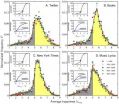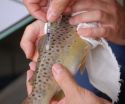Hydrogen advances graphene use
2012-01-13
(Press-News.org) Physicists at Linköping University have shown that a dose of hydrogen or helium can render the "super material" graphene even more useful.
Graphene has engendered high expectations whereof its extreme properties depend on the fact that it consists of a single sheet of carbon atoms. However the attraction forces between the atoms cause the sheets to be drawn to each other. One solution is to add atomic hydrogen between the layers.
Presented in the eminent journal Physical Review A, the researchers' calculations show that the hydrogen at a given concentration affects the atomic van der Waals forces and becomes repulsive instead of attractive. The result is that graphene sheets repel each other and float freely just a few nanometres apart (an example of the so-called quantum levitation).
Professor Bo E. Sernelius, who conducted the study in conjunction with his former doctoral student Mathias Boström, identifies several possible applications of the discovery:
Storage of hydrogen as vehicle fuel
Creation of a single graphene sheet by peeling them from a pile that has grown on a substrate of silicon carbide; a method developed at Linköping University
Repulsive forces are ideal for the manufacture of friction-free components on a Nano scale, for example, robots and sensors for medical purposes.
In the present study the researchers began with two undoped sheets of graphene on a substrate of silicon dioxide (silica). The starting position is the van der Waals attractive forces and the sheets are compelled closer together. However once atomic hydrogen is added, repulsive forces arise. A similar effect was observed using other gases such as molecular hydrogen (H2) and helium.
Graphene is a two-dimensional material, which means that it retains a very special character. It is flexible, transparent, stronger than a diamond and has a superior ability to conduct electric current. In 2010 André Geim and Konstantin Novoselov received a Nobel Prize in Physics because for the first time ever they succeeded in producing stable flakes of material.
INFORMATION:
Article:
Repulsive van der Waals forces due to hydrogen exposure on bilayer graphene by Mathias Boström and Bo E. Sernelius. Physical Review A 85:1, 11 January 2012.
END
ELSE PRESS RELEASES FROM THIS DATE:
2012-01-13
Thousands more American senior citizens with kidney disease are good candidates for transplants and could get them if physicians would get past outdated medical biases and put them on transplant waiting lists, according to a new study by Johns Hopkins researchers.
The Hopkins investigators estimate that between 1999 and 2006, roughly 9,000 adults over 65 would have been "excellent" transplant candidates and approximately 40,000 more older adults would have been "good" candidates for new kidneys. None, however, were given the chance.
"Doctors routinely believe and tell ...
2012-01-13
New Orleans, LA – A study led by Russell R. Russo, MD, a third-year Orthopaedic Surgery resident at LSU Health Sciences Center New Orleans School of Medicine, has identified a new source of life-threatening necrotizing fasciitis – "bath salts." The study, describing the first known case of necrotizing fasciitis from an intramuscular injection of the street drug known as "bath salts," is published in the January 2012 issue of Orthopedics, now available online.
Necrotizing fasciitis is an orthopedic emergency. The ability to quickly and accurately diagnose this rapidly ...
2012-01-13
TORONTO, Ont., Jan. 12, 2012—Researchers at St. Michael's Hospital have published the first detailed figures showing the risk of using the prescription drug Rasilez in combination with certain other blood pressure-lowering medications.
The pharmaceutical company Novartis terminated a large, international clinical trial of the drug last month after finding an increased incidence after 18-24 months of non-fatal strokes, renal complications, high levels of potassium in the blood and low blood pressure.
As a result, Health Canada said on Dec. 22 that it would review the ...
2012-01-13
A new study published in the journal Nature Medicine by NYU Cancer Institute researchers, shows how the cancer causing gene Notch, in combination with a mutated Polycomb Repressive Complex 2 (PRC2) protein complex, work together to cause T- cell acute lymphoblastic leukemia (T-ALL).
T-ALL is an aggressive blood cancer, predominately diagnosed in children. It occurs when one lymphoblast, an immature white blood cell, turns malignant, multiplying uncontrollably and spreading rapidly throughout the body. If left untreated, the disease can be fatal in a few weeks. Cancer-causing ...
2012-01-13
WEST LAFAYETTE, Ind. - Honeybee populations have been in serious decline for years, and Purdue University scientists may have identified one of the factors that cause bee deaths around agricultural fields.
Analyses of bees found dead in and around hives from several apiaries over two years in Indiana showed the presence of neonicotinoid insecticides, which are commonly used to coat corn and soybean seeds before planting. The research showed that those insecticides were present at high concentrations in waste talc that is exhausted from farm machinery during planting.
The ...
2012-01-13
"If it bleeds, it leads," goes the cynical saying with television and newspaper editors. In other words, most news is bad news and the worst news gets the big story on the front page.
So one might expect the New York Times to contain, on average, more negative and unhappy types of words — like "war," " funeral," "cancer," "murder" — than positive, happy ones — like "love," "peace" and "hero."
Or take Twitter. A popular image of what people tweet about may contain a lot of complaints about bad days, worse coffee, busted relationships and lousy sitcoms. Again, it might ...
2012-01-13
TAMPA, Fla. (Jan. 12, 2012) – Using two cell surface markers found to be highly expressed in breast cancer lymph node metastases, researchers at Moffitt Cancer Center, working with colleagues at other institutions, have developed targeted, fluorescent molecular imaging probes that can non-invasively detect breast cancer lymph node metastases. The new procedure could spare breast cancer patients invasive and unreliable sentinel lymph node (SLN) biopsies and surgery-associated negative side effects.
Their study was published in a recent issue of Clinical Cancer Research ...
2012-01-13
For years, researchers seeking new therapies for traumatic brain injury have been tantalized by the results of animal experiments with stem cells. In numerous studies, stem cell implantation has substantially improved brain function in experimental animals with brain trauma. But just how these improvements occur has remained a mystery.
Now, an important part of this puzzle has been pieced together by researchers at the University of Texas Medical Branch at Galveston. In experiments with both laboratory rats and an apparatus that enabled them to simulate the impact of ...
2012-01-13
Researchers at the University of Oviedo (Spain) have come up with a way of tagging gunpowder which allows its illegal use to be detected even after it has been detonated. Based on the addition of isotopes, the technique can also be used to track and differentiate between wild fish and those from a fish farm, such as trout and salmon.
A new method for tagging and identifying objects, substances and living beings has just been presented in this month's issue of the Analytical Chemistry journal. Its creators are scientists at the University of Oviedo who have patented the ...
2012-01-13
A new study on African bats provides a vital clue for unravelling the mysteries in Australia's battle with the deadly Hendra virus.
The study focused on an isolated colony of straw-coloured fruit bats on islands off the west coast of central Africa. By capturing the bats and collecting blood samples, scientists discovered these animals have antibodies that can neutralise deadly viruses known in Australia and Asia.
The paper is published today, 12 January, in the journal PLoS ONE, and is a collaboration of the Department of Veterinary Medicine at the University of ...
LAST 30 PRESS RELEASES:
[Press-News.org] Hydrogen advances graphene use

